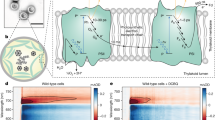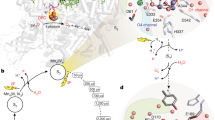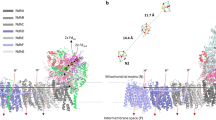Abstract
Light energy is transformed into chemical energy in photosynthesis by coupling a light-induced electron transfer to proton uptake. The resulting proton gradient drives ATP synthesis. In this study, we monitored the light-induced reactions in a 100-kDa photosynthetic protein from 30 ns to 35 s by FTIR difference spectroscopy. The results provide detailed mechanistic insights into the electron and proton transfer reactions of the QA to QB transition: reduction of QA in picoseconds induces protonation of histidines, probably of His126 and His128 in the H subunit at the entrance of the proton uptake channel, and of Asp210 in the L subunit inside the channel at 12 μs and 150 μs. This seems to be a prerequisite for the reduction of QB, mainly at 150 μs. QA− is reoxidized at 1.1 ms, and a proton is transferred from Asp210 to Glu212 in the L subunit, the proton donor to QB−. Notably, our data indicate that QB is not reduced directly by QA− but presumably through an intermediary electron donor.
This is a preview of subscription content, access via your institution
Access options
Subscribe to this journal
Receive 12 print issues and online access
$189.00 per year
only $15.75 per issue
Buy this article
- Purchase on Springer Link
- Instant access to full article PDF
Prices may be subject to local taxes which are calculated during checkout







Similar content being viewed by others
Accession codes
References
Okamura, M.Y., Paddock, M.L., Graige, M.S. & Feher, G. Proton and electron transfer in bacterial reaction centers. Biochim. Biophys. Acta 1458, 148–163 (2000).
Gerwert, K. Molecular reaction mechanisms of proteins as monitored by time-resolved FTIR spectroscopy. Curr. Opin. Struct. Biol. 3, 769–773 (1993).
Mäntele, W. Infrared and Fourier-transform infrared spectroscopy. In Biophysical Techniques in Photosynthesis (eds. Amesz, J. & Hoff, A.J.) 137–160 (Kluwer, Dordrecht, Netherlands, 1996).
Vogel, R. & Siebert, F. Vibrational spectroscopy as a tool for probing protein function. Curr. Opin. Chem. Biol. 4, 518–523 (2000).
Barth, A. & Zscherp, C. What vibrations tell us about proteins. Quart. Rev. Biophysics 35, 369–430 (2002).
Stowell, M.H.B. et al. Light-induced structural changes in photosynthetic reaction center: implications for mechanism of electron-proton transfer. Science 276, 812–816 (1997).
Zouni, A. et al. Crystal structure of photosystem II from Synechococcus elongatus at 3.8 Å resolution. Nature 409, 739–743 (1997).
Feher, G., Allen, J.P., Okamura, M.Y. & Rees, D.C. Structure and function of bacterial photosynthetic reaction centres. Nature 339, 111–116 (1989).
Ermler, U., Fritzsch, G., Buchanan, S. & Michel, H. Structure of the photosynthetic reaction centre from Rhodobacter sphaeroides at 2.65 Å resolution: cofactors and protein-cofactor interactions. Structure 2, 925–936 (1994).
Kuglstatter, A., Ermler, U., Michel, H., Baciou, L. & Fritzsch, G. X-ray structure analyses of photosynthetic reaction center variants from Rhodobacter sphaeroides: structural changes induced by point mutations at position L209 modulate electron and proton transfer. Biochemistry 40, 4253–4260 (2001).
Brudler, R. et al. Asymmetric binding of the 1- and 4-C=O groups of QA in Rhodobacter sphaeroides R26 reaction centres monitored by Fourier transform infra-red spectroscopy using site-specific isotopically labelled ubiquinone-10. EMBO J. 13, 5523–5530 (1994).
Breton, J., Boullais, C., Burie, J.-R., Nabedryk, E. & Mioskowski, C. Binding sites of quinones in photosynthetic bacterial reaction centers investigated by light-induced FTIR difference spectroscopy: assignment of the interactions of each carbonyl of QA in Rhodobacter sphaeroides using site-specific 13C-labeled ubiquinone. Biochemistry 33, 14378–14386 (1994).
Brudler, R. et al. FTIR spectroscopy shows weak symmetric hydrogen bonding of the QB carbonyl groups in Rhodobacter sphaeroides R26 reaction centres. FEBS Lett. 370, 88–92 (1995).
Breton, J., Boullais, C., Berger, G., Mioskowski, C. & Nabedryk, E. Binding sites of quinones in photosynthetic bacterial reaction centers investigated by light-induced FTIR difference spectroscopy: symmetry of the carbonyl interactions and close equivalence of the QB vibrations in Rhodobacter sphaeroides and Rhodopseudomonas viridis probed by isotope labeling. Biochemistry 34, 11606–11616 (1995).
Holzapfel, W. et al. Initial electron-transfer in the reaction center from Rhodobacter sphaeroides. Proc. Natl. Acad. Sci. USA 87, 5168–5172 (1990)
Gray, H.B. & Winkler, J.R. Electron transfer in proteins. Ann. Rev. Biochem. 65, 537–561 (1995).
Moser, C.C., Page, C.C., Farid, R. & Dutton, P.L. Biological electron transfer. J. Bioenerg. Biomembr. 27, 263–274 (1995).
Debus, R.J., Feher, G. & Okamura, M.Y. Iron-depleted reaction centers from Rhodopseudomonas sphaeroides R-26.1: characterization and reconstitution with Fe2+, Mn2+, Co2+, Ni2+, Cu2+, and Zn2+. Biochemistry 25, 2276–2287 (1986).
Tiede, D., Vázquez, J., Córdova, J. & Marone, P.A. Time-resolved electrochromism associated with the formation of quinone anions in Rhodobacter sphaeroides R-26 reaction center. Biochemistry 35, 10763–10775 (1996).
Graige, M.S., Feher, G. & Okamura, M.Y. Conformational gating of the electron transfer reaction QA−QB → QAQB− in bacterial reaction centers of Rhodobacter sphaeroides determined by a driving force assay. Proc. Natl. Acad. Sci. USA 95, 11679–11684 (1998).
Li, J., Gilroy, D., Tiede, D. & Gunner, M.R. Kinetic phases in the electron transfer from P+QA−QB to P+QAQB− and the associated processes in Rhodobacter sphaeroides R-26 reaction centers. Biochemistry 37, 2818–2829 (1998).
Li, J., Takahashi, E. & Gunner, M.R. −ΔG°AB and pH dependence of the electron transfer from P+QA−QB to P+QAQB− in Rhodobacter sphaeroides reaction centers. Biochemistry 39, 7445–7454 (2000).
Gerwert, K. Molecular reaction mechanisms of proteins monitored by time-resolved FTIR difference spectroscopy. In Handbook of Vibrational Spectroscopy (eds. Chalmers, J.M. & Griffiths, P.R.) (Wiley, Chichester, UK, 2001).
Hienerwadel, R. et al. Time-resolved infrared spectroscopy of electron transfer in bacterial photosynthetic reaction centers: dynamics of binding and interaction upon QA and QB reduction. Biochemistry 31, 5799–5808 (1992).
Hienerwadel, R. et al. Protonation of Glu L212 following QB− formation in the photosynthetic reaction center of Rhodobacter sphaeroides: evidence from time-resolved infrared spectroscopy. Biochemistry 34, 2832–2843 (1995).
Uhmann, W., Becker, A., Taran, C. & Siebert, F. Time-resolved FT-IR absorption spectroscopy using a step-scan interferometer. Appl. Spectrosc. 45, 390–397 (1991).
Burie, J.-R., Leibl, W., Nabedryk, E. & Breton, J. Step-scan FT-IR spectroscopy of electron transfer in the photosynthetic bacterial reaction center. Appl. Spectrosc. 47, 1401–1404 (1993).
Rammelsberg, R., Hessling, B., Chorongiewski, H. & Gerwert, K. Molecular reaction mechanisms of proteins monitored by nanosecond step-scan FT-IR difference spectroscopy. Appl. Spectrosc. 51, 558–562 (1997).
Brudler, R. & Gerwert, K. Step-scan FTIR spectroscopy of the QA–QB → QAQB– transition in Rb. sphaeroides R26 reaction centres. Photosynth. Res. 55, 261–266 (1998).
Hessling, B., Souvignier, G. & Gerwert, K. A model-independent approach to assigning bacteriorhodopsin's intramolecular reactions to photocycle intermediates. Biophysical J. 65, 1929–1941 (1993).
Gerwert, K., Souvignier, G. & Hess, B. Simultaneous monitoring of light-induced changes in protein side-group protonation, chromophore isomerization, and backbone motion of bacteriorhodopsin by time-resolved Fourier-transform infrared spectroscopy. Proc. Natl. Acad, Sci. USA 87, 9774–9778 (1990).
Brudler, R., Rammelsberg, R., Woo, T.T., Getzoff, E.D. & Gerwert, K. Structure of the I1 early intermediate of photoactive yellow protein by FTIR spectroscopy. Nat. Struct. Biol. 8, 265–270 (2001).
Nabedryk, E. et al. A protein conformational change associated with the photoreduction of the primary and secondary quinones in the bacterial reaction center. FEBS Lett. 266, 59–62 (1990).
Kleinfeld, D., Okamura, M.Y. & Feher, G. Electron-transfer kinetics in photosynthetic reaction centers cooled to cryogenic temperatures in the charge-separated state: evidence for light-induced structural changes. Biochemistry 23, 5780–5786 (1984).
Venyaminov, S.Yu. & Kalnin, N.N. Quantitative IR spectrophotometry of peptide compounds in water (H2O) solutions. I. Spectral parameters of amino acid residue absorption bands. Biopolymers 30, 1243–1257 (1990).
Nabedryk, E. et al. Fourier transform infrared difference spectroscopy of secondary quinone acceptor photoreduction in proton transfer mutants of Rhodobacter sphaeroides. Biochemistry 34, 14722–14732 (1995).
Breton, J., Nabedryk, E., Allen, J.P. & Williams, J.A.C. Electrostatic influence of QA reduction on the IR vibrational mode of the 10a-ester C=O of HA demonstrated by mutations at residues Glu L104 and Trp L100 in reaction centers from Rhodobacter sphaeroides. Biochemistry 36, 4515–4525 (1997).
Rammelsberg, R., Huhn, G., Lübben, M. & Gerwert, K. Bacteriorhodopsin's intramolecular proton-release pathway consists of a hydrogen-bonded network. Biochemistry 37, 5001–5009 (1998).
Lancaster, C.R.D. & Michel, H. The coupling of light-induced electron transfer and proton uptake as derived from crystal structures of reaction centres from Rhodopseudomonas viridis modified at the binding site of the secondary quinone, QB . Structure 5, 1339–1359 (1997).
Noguchi, T., Inoue, Y. & Tang, X.-S. Structure of a histidine ligand in the photosynthetic oxygen-evolving complex as studied by light-induced Fourier transform infrared difference spectroscopy. Biochemistry 38, 10187–10195 (1999).
Hasegawa, K., Ono, T. & Noguchi, T. Vibrational spectra and ab initio DFT calculations of 4-methylimidazole and its different protonation forms: infrared and raman markers of the protonation state of a histidine side chain. J. Phys. Chem. B. 104, 4253–4265 (2000).
Axelrod, H.L., Abresch, E.C., Paddock, M.L., Okamura, M.Y. & Feher, G. Determination of the binding sites of the proton transfer inhibitors Cd2+ and Zn2+ in bacterial reaction centers. Proc. Natl. Acad, Sci. USA 97, 1542–1547 (2000).
Ädelroth, P. et al. Identification of the proton pathway in bacterial reaction centers: decrease of proton transfer rate by mutation of surface histidines at H126 and H128 and chemical rescue by imidazole identifies the initial proton donors. Biochemistry 40, 14538–14546 (2001).
Paddock, M.L. et al. Identification of the proton pathway in bacterial reaction centers: cooperation between Asp-M17 and Asp-L210 facilitates proton transfer to the secondary quinone (QB). Biochemistry 40, 6893–6902 (2001).
Mezzetti, A. et al. Rapid-scan Fourier transform infrared spectroscopy shows coupling of Glu-L212 protonation and electron transfer to QB in Rhodobacter sphaeroides reaction centers. Biochim. Biophys. Acta 1553, 320–330 (2002).
Nabedryk, E., Breton, J., Okamura, M.Y. & Paddock, M.L. Simultaneous replacement of Asp-L210 and Asp-M17 with Asn increases proton uptake by Glu-L212 upon first electron transfer to QB in reaction centers from Rhodobacter sphaeroides. Biochemistry 40, 13826–13832 (2001).
Maróti, P. & Wraight, C.A. Flash-induced H+ binding by bacterial photosynthetic reaction centers: comparison of spectrophotometric and conductimetric methods. Biochim. Biophys. Acta 934, 314–328 (1988).
Breton, J. et al. Vibrational spectroscopy favors a unique QB binding site at the proximal position in wild-type reaction centers and in the Pro-L209 → Tyr mutant from Rhodobacter sphaeroides. Biochemistry 41, 12921–12927 (2002).
Spassov, V.Z., Luecke, H., Bashford, D. & Gerwert, K. pKa calculations suggest storage of an excess proton in a hydrogen-bonded water network in bacteriorhodopsin. J. Mol. Biol. 312, 203–219 (2001).
Nugent, J.H.A. Oxygenic photosynthesis—electron transfer in photosystem I and photosystem II. Eur. J. Biochem. 237, 519–531 (1996).
Farchaus, J.W. & Oesterhelt, D. A Rhodobacter sphaeroides puf L, M and X deletion mutant and its complementation in trans with a 5.3 kb puf operon shuttle fragment. EMBO J. 8, 47–54 (1989).
Remy, A. Der QA−QB → QAQB−-Übergang im bakteriellen photosynthetischen Reaktionszentrum von Rhodobacter sphaeroides. Thesis, Ruhr-University Bochum, Bochum, Germany (2002).
Okamura, M.Y., Isaacson, R.A. & Feher, G. Primary acceptor in bacterial photosynthesis: obligatory role of ubiquinone in photoactive reaction centers of Rhodopseudomonas spheroides. Proc. Nat. Acad. Sci. USA 72, 3491–3495 (1975).
Acknowledgements
This work was financially supported by the Deutsche Forschungsgemeinschaft. We thank T.A. Egorova-Zachernyuk for providing RC sample material and D. Oesterhelt for providing the Rb. sphaeroides deletion strain pufΔLMX21. We thank C. Fichtner for help in mutagenesis, C. Kandt for preparing Figures 1 and 7 and R. Goody for careful reading of the manuscript.
Author information
Authors and Affiliations
Corresponding author
Ethics declarations
Competing interests
The authors declare no competing financial interests.
Rights and permissions
About this article
Cite this article
Remy, A., Gerwert, K. Coupling of light-induced electron transfer to proton uptake in photosynthesis. Nat Struct Mol Biol 10, 637–644 (2003). https://doi.org/10.1038/nsb954
Received:
Accepted:
Published:
Issue Date:
DOI: https://doi.org/10.1038/nsb954
This article is cited by
-
Time-resolved infrared absorption spectroscopy applied to photoinduced reactions: how and why
Photochemical & Photobiological Sciences (2022)
-
A single residue controls electron transfer gating in photosynthetic reaction centers
Scientific Reports (2017)
-
Time-resolved infrared spectroscopy in the study of photosynthetic systems
Photosynthesis Research (2017)
-
Demonstration of asymmetric electron conduction in pseudosymmetrical photosynthetic reaction centre proteins in an electrical circuit
Nature Communications (2015)
-
Ubiquinol formation in isolated photosynthetic reaction centres monitored by time-resolved differential FTIR in combination with 2D correlation spectroscopy and multivariate curve resolution
Analytical and Bioanalytical Chemistry (2011)



